 |

CS201
Introduction to Programming
Lecture
Handout
Introduction
to Programming
Lecture
No. 16
Reading
Material
Deitel
& Deitel - C++ How to
Program
Chapter 5,
18
5.9,
5.10, 18.4
Summary
�
Pointers
(continued)
�
Multi-dimensional
Arrays
�
Pointers
to Pointers
�
Command-line
Arguments
�
Exercises
�
Tips
Pointers
(continued)
We will
continue with the elaboration of
the concept of pointers in
this lecture. To further
understand
pointers, let's consider the
following statement.
char
myName[] = "Full
Name";
This
statement creates a 'char' type
array and populates it with
a string. Remember the
character
strings are null ( '\0' )
terminated. We can achieve the
same thing with the
use
of pointer as
under:
char *
myNamePtr = "Full
Name";
Page
173
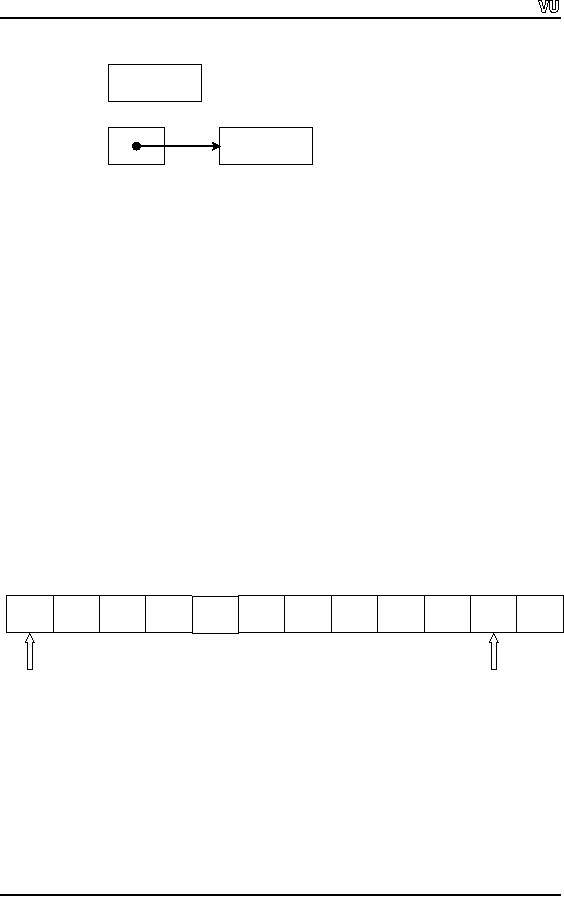
CS201
Introduction to Programming
myName
Full
Name\0
myNamePtr
Full
Name\0
Let's
see what's the difference between
these two approaches?
When we
create an array, the array
name, 'myName' in this case,
is a constant pointer.
The
starting address of the memory
allocated to string "FullName" becomes
the contents
of the
array name 'myName' and
the array name 'myName'
can not be assigned any
other
value. In
other words, the location to
which array names points to
can not be changed.
In
the
second statement, the
'myNamePtr' is a pointer to a string "FullName",
which can
always be
changed to point to some
other string.
Hence,
the array names can be
used as pointers but only as
constant ones.
Multi-dimensional
Arrays
Now we
will see what is the
relationship between the name of
the array and the
pointer.
Suppose
we have a two-dimensional
array:
char
multi[5][10];
In the
above statement, we have
declared a 'char' type array of 5
rows and 10 columns.
[0]
[1]
[2]
[3]
[5]
[6]
[7]
[8]
[9]
[0]
[1]
[4]
75
72
68
82
79
69
67
73
77
83
80
80
1st row 1st
col
2nd row 1st
col
Multi-dimensional
array in the memory
As
discussed above, the array
name points to the starting memory
location of the
memory
allocated
for the array elements. Here
the question arises where
the 'multi' will be
pointing
if we add 1 to `multi'.
We know
that a pointer is incremented by its type
number of bytes. In this
case, 'multi' is
an array
of 'char' type that takes 1 byte.
Therefore, `muti+1' should
take us to the second
Page
174
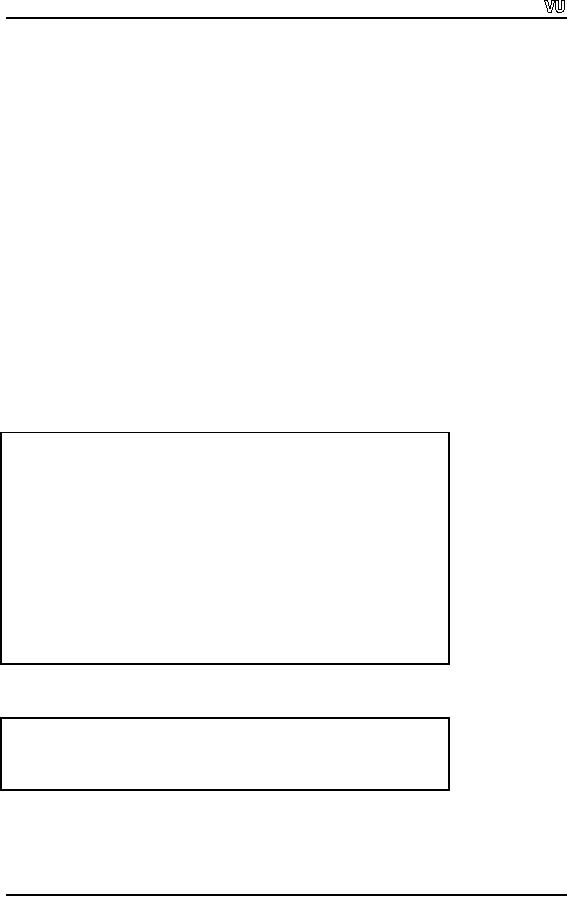
CS201
Introduction to Programming
element
of the first row (row
0). But this time, it is
behaving differently. It is pointing
to
the
first element (col 0) of the
second row (row 1). So by
adding '1' in the array
name, it
has
jumped the whole row or jumped
over as many memory locations as
number of
columns in
the array. The width of
the columns depends upon the
type of the data inside
columns. Here,
the data type is 'char',
which is of 1 byte. As the number of
columns for
this
array 'multi' is 10, it has
jumped 10 bytes.
Remember,
whenever some number is
added in an array name, it
will jump as many
rows
as the
added number. If we want to go to
the second row (row 1)
and third column (col
2)
using
the same technique, it is given
ahead but it is not as that
straight forward.
Remember,
if the array is to be accessed in
random order, then the
pointer approach may
not be
better than array
indexing.
We
already know how to
dereference array elements
using indexing. So the
element at
second
row and third column
can be accessed as
'multi[1][2]'.
To do
dereferencing using pointers we
use '*' operator. In case of
one-dimensional array,
'*multi'
means 'the value at the
address, pointed to by the
name of the array'. But
for two-
dimensional
array '*multi' still
contains an address of the
first element of the first
row of
the
array or starting address of the
array 'multi'. See the
code snippet to prove
it.
/* This
program uses the
multi-dimensional array name as pointer
*/
#include
<iostream.h>
void
main(void)
{
//To
avoid any confusion, we have
used `int' type
below
int
multi[5][10];
cout
<< "\n The value of
multi is: " <<
multi;
cout
<< "\n The value of
*multi is: " <<
*multi;
}
Now,
look at the output
below:
The
value of multi is:
0x22feb0
The
value of *multi is:
0x22feb0
It is
pertinent to note that in
the above code, the
array `multi' has been
changed to `int'
from
`char' type to avoid any
confusion.
Page
175

CS201
Introduction to Programming
To access
the elements of the
two-dimensional array, we do double
dereferencing like
'**multi'.
If we want to go to, say, 4th
row (row 3), it is achieved
as 'multi + 3' . Once
reached
in the desired row, we can
dereference to go to the desired
column. Let's say we
want to
go to the 4th column (col
3). It can be done in the
following manner.
*(*(multi+3)+3)
This is
an alternative way of manipulating
arrays. So 'multi[3][3]' element
can also be
accessed
by '*(*(multi+3)+3)'.
There is
another alternative of doing this by
using the normal pointer.
Following code
reflects
it.
/* This
program uses array
manipulation using indexing
*/
#include
<iostream.h>
void
main(void)
{
int
multi [5][10];
int
*ptr;
// A
normal `int' pointer
ptr =
*multi;
// `ptr'
is assigned the starting address of
the first row
/*
Initialize the array
elements */
for(int
i=0; i < 5; i++)
{
for
(int j=0; j < 10;
j++)
{
multi[i][j]
= i * j;
}
}
/* Array
manipulation using indexing
*/
cout
<< "\n Array manipulated using
indexing is: \n";
for(int
i=0; i < 5; i++)
{
for
(int j=0; j < 10;
j++)
{
cout
<< multi[i][j] << '\t';
}
cout
<< '\n';
}
/* Array
manipulation using pointer */
cout
<< "\n Array manipulated using
pointer is: \n";
for(int
k=0; k < 50; k++, ptr
++)
// 5 * 10 =
50
{
cout
<< *ptr << '\t';
}
Page
176
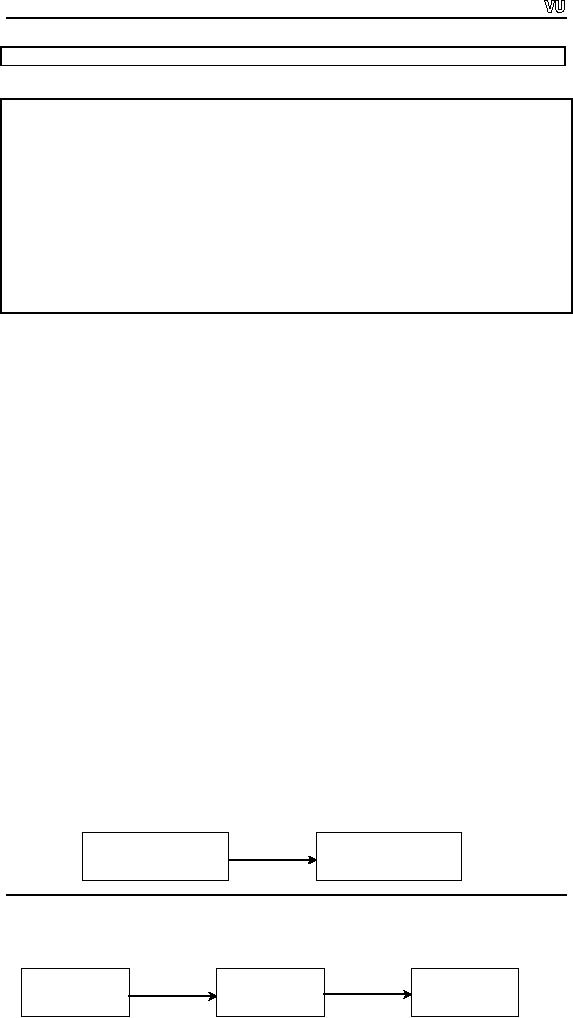
CS201
Introduction to Programming
}
The
output of this program is:
Array
manipulated using indexing
is:
0
0
0
0
0
0
0
0
0
0
0
1
2
3
4
5
6
7
8
9
0
2
4
6
8
10
12
14
16
18
0
3
6
9
12
15
18
21
24
27
0
4
8
12
16
20
24
28
32
36
Array
manipulated using pointer is:
0
0
0
0
0
0
0
0
0
0
0
1
2
3
4
5
6
7
8
9
0
2
4
6
8
10
12
14
16
18
0
3
6
9
12
15
18
21
24
27
0
4
8
12
16
20
24
28
32
36
The
above line of output of array
manipulation is wrapped because of
the fixed width of
the
table. Actually, it is a single
line.
Why it is
a single line? As discussed in the
previous lectures, computer stores
array in
straight
line (contiguous memory locations).
This straight line is just due to
the fact that a
function
accepting a multi-dimensional array as an
argument, needs to know all
the
dimensions of
the array except the
leftmost one. In case of
two-dimensional array,
the
function
needs to know the number of
columns so that it has much
information about the
end
and start of rows within an
array.
It is
recommended to write programs to
understand and practice the
concepts of double
dereferencing,
single dereferencing, incrementing the
name of the array to
access
different
rows and columns etc. Only
hands on practice will help
understand the
concept
thoroughly.
Pointers to
Pointers
What we
have been talking about,
now we will introduce a new
terminology, is actually a
case of
`Pointer to Pointer'. We were doing double
dereferencing to access the
elements
of a
two-dimensional array by using
array name (a pointer) to access a
row (another
pointer)
and further to access a column
element (of `int' data
type).
In case
of single dereference, the value of
the pointer is the address of
the variable that
contains
the value desired as shown in
the following figure. In the
case of pointer to
pointer or
double dereference, the
first pointer contains the
address of the second
pointer,
which
contains the address of the
variable, which contains the
desired value.
Pi
V i
bl
address
value
Page
177
Si l I
di
i (i l d
f
)
Pi
Pi
V i
bl

CS201
Introduction to Programming
Pointers
to Pointers are very useful.
But you need to be very
careful while using
the
technique
to avoid any problem.
Earlier,
we used arrays and pointers
interchangeably. We can think
that a pointer to
pointer is
like a pointer to a group of arrays
because a pointer itself can be
considered as
an array.
We can elaborate with the
following example by declaring character
strings.
While
using an array, we at first
decide about the length of
the array. For example,
you
are
asked to calculate the
average age of your class
using the array. What would
be the
dimension of
the array? Normally, you
will look around, count
the students of the
class
and
keep the same size of the
array as the number of
students, say 53. Being a
good
programmer,
you will look ahead
and think about the
maximum size of the class in
the
future
and decide to take the size
of the array as 100. Here,
you have taken care of
the
future
requirements and made the
program flexible. But the
best thing could be: to get
the
size of
the array from the
user at runtime and set it
in the program instead of declaring
the
array of
maximum size. We will cover
this topic at some later
stage.
When we
initialize an array with a
character string, the number of
characters in the
character
string determines the length of array
(plus one character to include the
`\0'
character).
eg. it is a single-dimensional
array:
char
name[] = "My full
name";
The size
of the `name' array is
13.
Suppose,
we have a group of character
strings and we want to store
them in a two-
dimensional
array. As we already discussed, an
array has same number of
columns in
each
row, e.g. a[5][10] array
has 10 columns in each row.
Now if we store
character
strings
of variable length in a two-dimensional array, it is
necessary to set the number
of
columns of
the array as the length of
the longest character string in
the group (plus 1 byte
for
`\0' character). But the
space within rows of the
array would be wasted for
all
character
strings with shorter length as
compared to the number of columns. We
don't
want to
waste this space and
want to occupy the minimum
space required to store
a
character
string in the memory.
If we use
the conventional two-dimensional array
like a [5] [10], there is no
way of using
variable
space for rows. All the
rows will have fixed
'10' number of columns in this
case.
But in
case of an Array of Pointers, we
can allocate variable space. An
array of pointers
Page
178
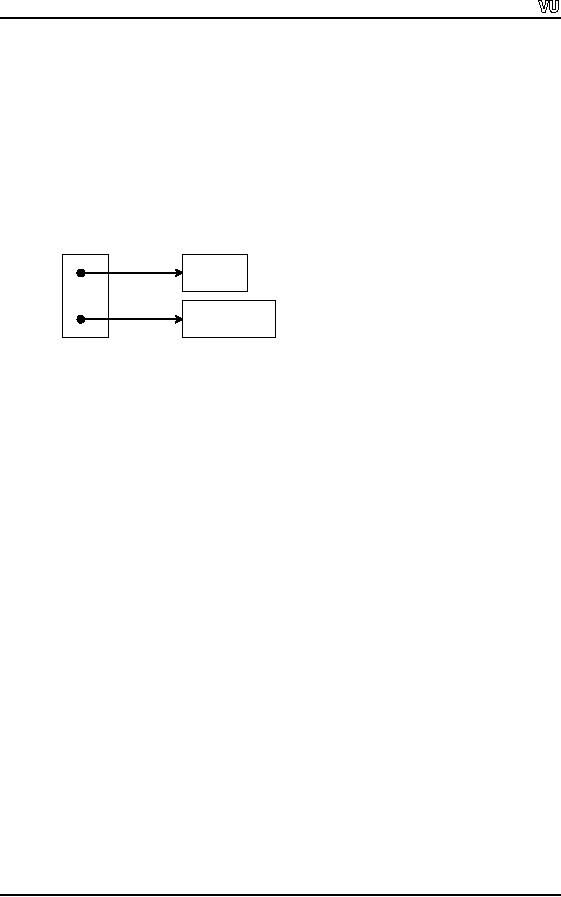
CS201
Introduction to Programming
is used
to store pointers in it. Now
we will try to understand
how do we declare an
array
of
pointers. The following
statement can help us in
comprehending it properly.
char *
myarray[10];
We read
it as: `myarray is an array of 10
pointers to character'. If we take
out the size of
the
array, it will become variable
as:
char *
myarray[] = {"Amir",
"Jehangir"};
myarray
Amir\0
For
first pointer myarray[0], 5Jehangir\0bytes
for `Amir' plus 1 byte for
`\0') of memory
bytes
(4
has
been allocated. For second
pointer myarray[1], 9 bytes of memory is
allocated. So
this is
variable allocation depending on the length of
character string.
What
this construct has done
for us? If we use normal
two-dimensional array, it
will
require
fixed space for rows
and columns. Therefore, we have
used array of pointers
here.
We
declared an array of pointers
and initialized it with variable length
character strings.
The
compiler allocates the same
space as required for the
character string to fit
in.
Therefore,
no space goes waste. This
approach has huge
advantage.
We will
know more about Pointers to
Pointers within next topic
of Command-line
Arguments
and also in the case
study given at the end of
this lecture.
Command
Line Arguments
Until
now, we have always written
the `main()' function as
under:
main(
)
{
. . . //
code statements
}
But we
are now in a position to
write something inside the parenthesis of
the `main()'
function.
In C language, whenever a program is
executed, the user can
provide the
command-line
arguments to it like:
C:\Dev-cpp\work>Program-name
argument1
argument2
......argumentN
We have
so far been taking input
using the `cout' and
`cin' in the program. But
now we
can
also pass arguments from
the command line just before
executing the program. For
this
purpose, we will need a mechanism. In C,
this can be done by using
`argc' and `argv'
arguments
inside the main( ) function
as:
Page
179

CS201
Introduction to Programming
void
main(int argc, char
**argv)
{
...
}
Note
that `argc' and `argv'
are conventional names of the command
line parameters of
the
`main()' function. However,
you can give the
desired names to them.
argc =
Number of command line arguments.
Its type is `int'.
argv = It
is a pointer to an array of character
strings that contain the
arguments, one per
string.
`**argv' can be read as pointer to
pointer to char.
Page
180
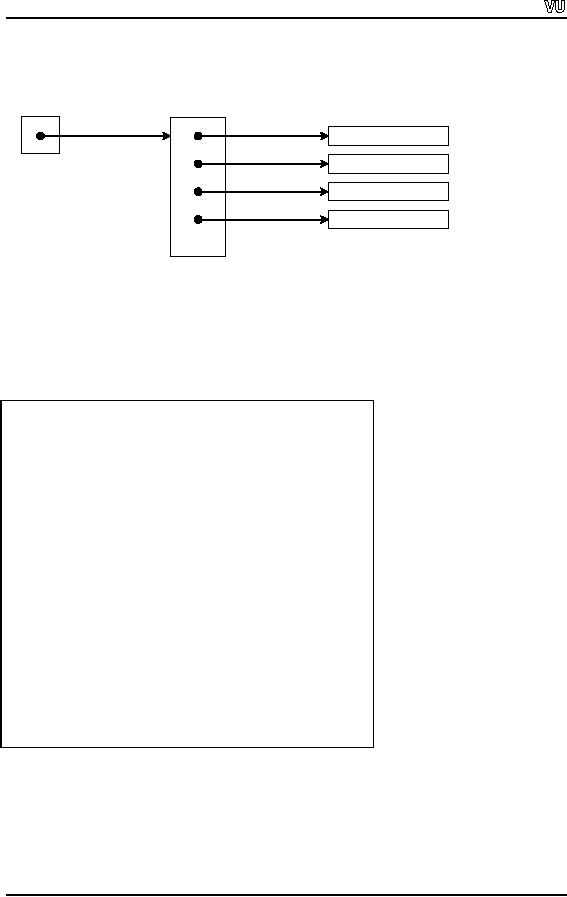
CS201
Introduction to Programming
argv
Program-name
Argument
1
Argument
2
Argument
3
0
Now
the command line arguments
can be accessed from inside
the program using
`argc'
and
`argv' variables. It will be an
interesting experience for you to
try out the
following
code:
/* Accessing
the command line arguments
*/
#include
<iostream.h>
main(int
argc, char **argv)
{
cout
<< argc << endl;
cout
<< *argv;
}
If we run
this program without any
argument, then what should
be the answer. It will
be
not
correct to think that the
argc (number of arguments) is zero as we
have not passed
any
argument.
It counts program name as the
first argument. So programs
written in C/C++
know
their names supplied in the first
command-line argument. By running the
above
program,
we can have the following
output:
Page
181
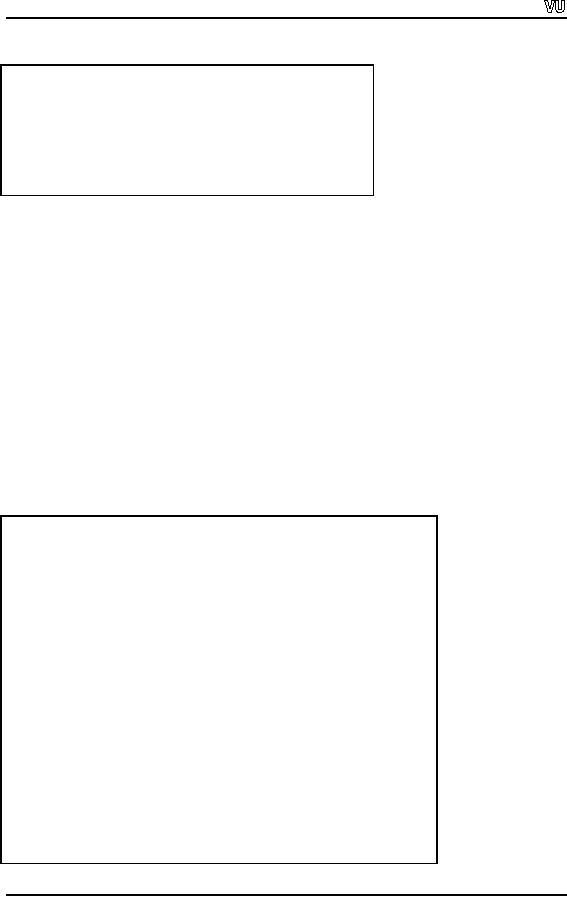
CS201
Introduction to Programming
c:\dev-cpp\work>program
1
program
Here we
see that the number of
arguments is 1 with the
first argument as the
program
name
itself. You have to go to
the command prompt to provide the command
line
arguments
or you can discuss on the
discussion board, how to use
Dev-C++ to pass
command
line arguments.
The
command line arguments are
separated by spaces. You can
provide command line
arguments
to a program as under:
c:\dev-cpp\work>program
1 2
Here the
number of arguments (argc)
will be 3. The argument "1"
and "2" are available
inside
the program as character strings.
Therefore, you have to
convert them into
integers
to ensure
their usage as as numbers.
This
has been further explained in the
following program. It counts
down from a value
specified on
the command line and beeps
when it reaches 0.
/* This
program explains the use of command
line arguments */
#include
<iostream.h>
#include
<stdlib.h>
//Included
for `atoi( )' function
main(int
argc, char **argv)
{
int disp,
count;
Page
182

CS201
Introduction to Programming
if(argc
< 2)
{
cout
<< "Enter the length of the
count\n";
cout
<< "on the command line.
Try again.\n";
return
1;
}
if(argc
== 3 && !strcmp(*(argv + 2),
"display"))
{
disp =
1;
}
else
{
disp =
0;
}
for(count =
atoi(*(argv + 1)); count; --count)
{
if(disp)
Page
183

CS201
Introduction to Programming
{
cout
<< count <<' ';
}
}
cout
<< '\a'; // '\a'causes the computer
to beep
return
0;
}
You must
have noted that if no
arguments are specified, an error
message will be printed.
It is
common for a program that
uses command-line arguments to
issue instructions if an
attempt
has been made to run it
without the availability of
proper information. The
first
argument
containing the number is converted
into an integer using the
standard function
`atoi(
)'. Similarly, if the string
`display' is present as the
second command-line
argument,
the count will also be
displayed on the screen.
In theory,
you can have up to 32,767
arguments but most operating
systems do not allow
more than
a few because of the fixed
maximum length of command-line.
These
arguments
are normally used to indicate a
file name or an option. Using
command-line
arguments
lends your program a very
professional touch and
facilitates the program's
use
in batch
files.
Case
Study: A Card Shuffling and
Dealing Simulation
Now we
want to move on to a real-world example
where we can demonstrate pointer
to
pointer
mechanism.
Problem:
Write a
program to randomly shuffle the
deck of cards and to deal it
out.
Some
Facts of Card
Games:
- There are 4
suits in one deck: Hearts,
Spades, Diamonds and Clubs.
Page
184

CS201
Introduction to Programming
Each
suit has 13 cards: Ace,
Deuce, Three, Four, Five,
Six, Seven, Eight, Nine,
Ten,
-
Jack,
Queen and King.
- A deck has
13 * 4 = 52 cards in total.
Problem
Analysis, Design and
Implementation:
As obvious
from the problem statement, we
are dealing with the deck of
cards, required
to be
identified. A card is identified by
its suit i.e. it may be one
of the Hearts,
Spades,
Diamonds or Clubs.
Also every card has
one value in the range
starting from Ace to
King. So
we want to identify them in our program
and our requirement is to
use English
like
`five of Clubs'. We will
declare one array of suit
like:
const
char *suite[4] = {"Hearts",
"Diamonds", "Clubs", "Spades" };
The
second array is of values of
cards:
const
char *face[13] = { "Ace",
"Deuce", "Three", "Four",
"Five", "Six",
"Seven",
"Eight", "Nine", "Ten",
"Jack", "Queen" and
"King"};
You must
have noticed the use of
array of pointers and
`const' keyword here. Both
the
arrays
are declared in a way to avoid
any wastage of space. Also
notice the use of
`const'
keyword.
We declared arrays as constants
because we want to use these
values without
modifying
them.
Now we
come to deck which has 52
cards. The deck is the
one that is being shuffled
and
dealt.
Definitely, it has some
algorithmic requirements.
Firstly,
what should be size and
structure of the deck. It
can either be linear array of
52
elements
or 4 suites and 13 values
(faces) per suit. Logically, it
makes sense to have
two-
dimensional
array of 4 suites and 13
faces per suit
like:
int
deck[4][13] = {0};
We will
now think in terms of
Algorithm Analysis.
The
`deck' is initialized with
the 0 value, so that it
holds no cards at start or it is
empty.
We want
to distribute 52 cards. Who will
load the `deck' first,
shuffle the cards and
deal
them out.
How to do it?
As we
want to select 52 cards (a
deck) randomly, therefore, we
can think of a loop to
get
one
card randomly in every iteration. We
will randomly choose one out
of the 4 suites
and
select one value out of 13
values and store the
card with its card
number value in the
deck. By
this way, we will be writing
numbers in the two-dimensional
array of `deck'
randomly.
That functionality is part of
`shuffle ()'
function.
Page
185

CS201
Introduction to Programming
void
shuffle( int wDeck[][13]
)
{
int
row, column, card;
for (
card = 1; card <= 52;
card++){
do{
row =
rand() % 4;
column =
rand() % 13;
} while(
wDeck [ row ][ column ] != 0
);
wDeck[
row ][ column ] =
card;
}
}
You
have noticed the `rand()'
function usage to generate
random numbers. We
are
dividing
the randomly generated
number by 4 and 13 to ensure
that we get numbers
within
our desired range. That is 0
to 3 for suites and 0 to 12
for values or faces. You
also
see
the condition inside the
`while statement, `wDeck[
row ][ column ] != 0 `. This is
to
ensure
that we don't overwrite row
and column, which has
already been occupied
by
some
card.
Now we
want to deal the deck.
How to deal it?
"At
first, search for card
number 1 inside the deck, wherever it is
found inside the `deck'
array,
note down the row of
this element. Use this row
to get the name of the
suite from
the
`suite' array. Similarly use
the column to take out the
value of the card from
the `face'
array."
See that the deal
function is quite simple
now.
void
deal( const int wDeck[][ 13
], const char *wFace[],
const char *wSuit[])
{
int
card, row, column;
for (
card = 1; card <= 52; card++
)
for(
row = 0; row <= 3;
row++)
for(
column = 0; column <= 12;
column++)
if(
wDeck[ row ][ column ] ==
card )
cout
<< card << ". " <<wFace[
column ] <<
" of " <<
wSuit [row ] << '\n';
}
Here, we
are not doing binary search
that is more efficient. Instead, we
are using simple
brute
force search. Also see the
`for loops' carefully and
how we are printing the
desired
output.
Now we
will discuss a little bit
about the srand() function
used while generating
random
numbers.
We know that computers can
generate random numbers
through the `rand()'
function.
Is it truly random? Be sure , it is
not truly random. If you
call `rand()'
function
Page
186

CS201
Introduction to Programming
again
and again. It will give
you numbers in the same
sequence. If you want your
number
to be
really random number, it is
better to set the sequence
to start every time from a
new
value. We
have used `srand()' function
for this purpose. It is a
seed to the random
number
generator.
Seed initializes the random
number generator with a
different value every
time
to
generate true random
numbers. We call `srand()' function
with a different value
every
time.
The argument to `srand()' function is
taken from the `time()'
function which is
giving us
a new value after every
one second. Every time we
try to run the
program,
`time()'
returns a different number of
seconds, which are passed to
`srand()' function as
an
argument so that the seed to
the random number generator
is a different number. It
means
that the random number
generator now generates a
different sequence of
random
numbers.
Although,
you can copy this program
and see the output after
executing it, but this is
not
the
objective of this exercise. You
are required to study the
problem and see the
constructs
very carefully. In this problem,
you have examples of nested
loops, array of
pointers,
variable sized strings in an array of pointers
and random number usage in
the
real
world problem etc.
/* Card
shuffling and dealing program
*/
#include
<iostream.h>
#include
<stdlib.h>
#include
<time.h>
void
shuffle( int [] [ 13
]);
void
deal( const int [][ 13 ],
const char *[], const
char *[]);
int
main()
{
Page
187

CS201
Introduction to Programming
const
char *suite[ 4 ] = {"Hearts",
"Diamonds", "Clubs", "Spades"
};
const
char *face[ 13 ] = { "Ace",
"Deuce", "Three", "Four", "Five",
"Six", "Seven",
"Eight",
"Nine", "Ten", "Jack", "Queen",
"King"};
int deck[
4 ][ 13 ] = { 0 };
srand(
time( 0 ) );
shuffle(
deck );
deal(
deck, face, suite );
return
0;
}
void
shuffle( int wDeck[][13]
)
{
int
row, column, card;
for (
card = 1; card <= 52;
card++){
do{
Page
188

CS201
Introduction to Programming
row =
rand() % 4;
column =
rand() % 13;
} while(
wDeck [ row ][ column ] != 0
);
wDeck[
row ][ column ] =
card;
}
}
void
deal( const int wDeck[][ 13
], const char *wFace[],
const char *wSuit[])
{
int
card, row, column;
const
char *space;
for (
card = 1; card <= 52; card++
)
for(
row = 0; row <= 3;
row++)
for(
column = 0; column <= 12;
column++)
if(
wDeck[ row ][ column ] ==
card )
cout
<< card << ". " <<wFace[
column ] << " of " <<
wSuit
[row ]
<< '\n';
Page
189

CS201
Introduction to Programming
}
A sample
output of the program
is:
1. Six of
Diamonds
2. Ten of
Hearts
3. Nine
of Clubs
4. King
of Hearts
5. Queen
of Clubs
6. Five
of Clubs
7. Queen
of Hearts
8. Eight
of Hearts
9. Ace of
Diamonds
10.
Ten of Diamonds
11.
Seven of Spades
12.
Ten of Clubs
13.
Seven of Clubs
14.
Three of Spades
15.
Deuce of Clubs
Page
190

CS201
Introduction to Programming
16.
Eight of Diamonds
17.
Eight of Clubs
18.
Nine of Spades
19.
Three of Clubs
20.
Jack of Clubs
21.
Queen of Spades
22.
Jack of Hearts
23.
Jack of Spades
24.
Jack of Diamonds
25.
King of Diamonds
26.
Seven of Hearts
27.
Five of Spades
28.
Seven of Diamonds
29.
Deuce of Hearts
30.
Ace of Spades
31.
Five of Diamonds
32.
Three of Hearts
33.
Six of Clubs
34.
Four of Hearts
Page
191

CS201
Introduction to Programming
35.
Ten of Spades
36.
Deuce of Spades
37.
Three of Diamonds
38.
Eight of Spades
39.
Nine of Hearts
40.
Ace of Clubs
41.
Four of Spades
42.
Queen of Diamonds
43.
King of Clubs
44.
Five of Hearts
45.
Ace of Hearts
46.
Deuce of Diamonds
47.
Four of Diamonds
48.
Four of Clubs
49.
Six of Hearts
50.
Six of Spades
51.
King of Spades
52.
Nine of Diamonds
Page
192

CS201
Introduction to Programming
Exercises
1. Write
the program `tail', which prints
the last n lines of its
input. By default, n is 10,
let's
say, but it can be changed
by an optional argument, so
that
tail
-n
prints
the last n lines.
Tips
Pointers
and arrays are closely
related in C. The array
names can be used as
pointers
but
only as constant
pointers.
A
function receiving a multi-dimensional
array as a parameter must minimally
define
all
dimensions except the leftmost
one.
Each
time a pointer is incremented, it points to
the memory location of the
next
element
of its base type but in
case of two-dimensional array, if
you add some
number in
a two-dimensional array name, it
will jump as many rows as
the added
number.
If the
array is to be accessed in random
order, then the pointer
approach may not be
better
than array indexing.
The
use of pointers may reduce
the wastage of memory space.
As discussed in this
lecture
if we store a set of character
strings of different lengths in a
two-dimensional
array,
the memory space is
wasted.
Pointers
may be arrayed (stored in an
array) like any other
data type.
An array
of pointers is the same as
pointers to pointers.
Although,
you can give your desired
names to the command line
parameters inside
`main()'
function but `argc' and
`argv' are conventionally
used.
Page
193
Table of Contents:
- What is programming
- System Software, Application Software, C language
- C language: Variables, Data Types, Arithmetic Operators, Precedence of Operators
- C++: Examples of Expressions, Use of Operators
- Flow Charting, if/else structure, Logical Operators
- Repetition Structure (Loop), Overflow Condition, Infinite Loop, Properties of While loop, Flow Chart
- Do-While Statement, for Statement, Increment/decrement Operators
- Switch Statement, Break Statement, Continue Statement, Rules for structured Programming/Flow Charting
- Functions in C: Structure of a Function, Declaration and Definition of a Function
- Header Files, Scope of Identifiers, Functions, Call by Value, Call by Reference
- Arrays: Initialization of Arrays, Copying Arrays, Linear Search
- Character Arrays: Arrays Comparisonm, Sorting Arrays Searching arrays, Functions arrays, Multidimensional Arrays
- Array Manipulation, Real World Problem and Design Recipe
- Pointers: Declaration of Pointers, Bubble Sort Example, Pointers and Call By Reference
- Introduction, Relationship between Pointers and Arrays, Pointer Expressions and Arithmetic, Pointers Comparison, Pointer, String and Arrays
- Multi-dimensional Arrays, Pointers to Pointers, Command-line Arguments
- String Handling, String Manipulation Functions, Character Handling Functions, String Conversion Functions
- Files: Text File Handling, Output File Handling
- Sequential Access Files, Random Access Files, Setting the Position in a File, seekg() and tellg() Functions
- Structures, Declaration of a Structure, Initializing Structures, Functions and structures, Arrays of structures, sizeof operator
- Bit Manipulation Operators, AND Operator, OR Operator, Exclusive OR Operator, NOT Operator Bit Flags Masking Unsigned Integers
- Bitwise Manipulation and Assignment Operator, Programming Constructs
- Pre-processor, include directive, define directive, Other Preprocessor Directives, Macros
- Dynamic Memory Allocation, calloc, malloc, realloc Function, Dangling Pointers
- History of C/C++, Structured Programming, Default Function Arguments
- Classes and Objects, Structure of a class, Constructor
- Classes And Objects, Types of Constructors, Utility Functions, Destructors
- Memory Allocation in C++, Operator and Classes, Structures, Function in C++,
- Declaration of Friend Functions, Friend Classes
- Difference Between References and Pointers, Dangling References
- Operator Overloading, Non-member Operator Functions
- Overloading Minus Operator, Operators with Date Class, Unary Operators
- Assignment Operator, Self Assignmentm, Pointer, Conversions
- Dynamic Arrays of Objects, Overloading new and delete Operators
- Source and Destination of streams, Formatted Input and Output, Buffered Input/Output
- Stream Manipulations, Manipulators, Non Parameterized Manipulators, Formatting Manipulation
- Overloading Insertion and Extraction Operators
- User Defined Manipulator, Static keyword, Static Objects
- Pointers, References, Call by Value, Call by Reference, Dynamic Memory Allocation
- Advantages of Objects as Class Members, Structures as Class Members
- Overloading Template Functions, Template Functions and Objects
- Class Templates and Nontype Parameters, Templates and Static Members
- Matrices, Design Recipe, Problem Analysis, Design Issues and Class Interface
- Matrix Constructor, Matrix Class, Utility Functions of Matrix, Input, Transpose Function
- Operator Functions: Assignment, Addition, Plus-equal, Overloaded Plus, Minus, Multiplication, Insertion and Extraction